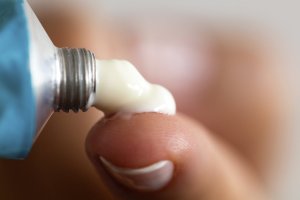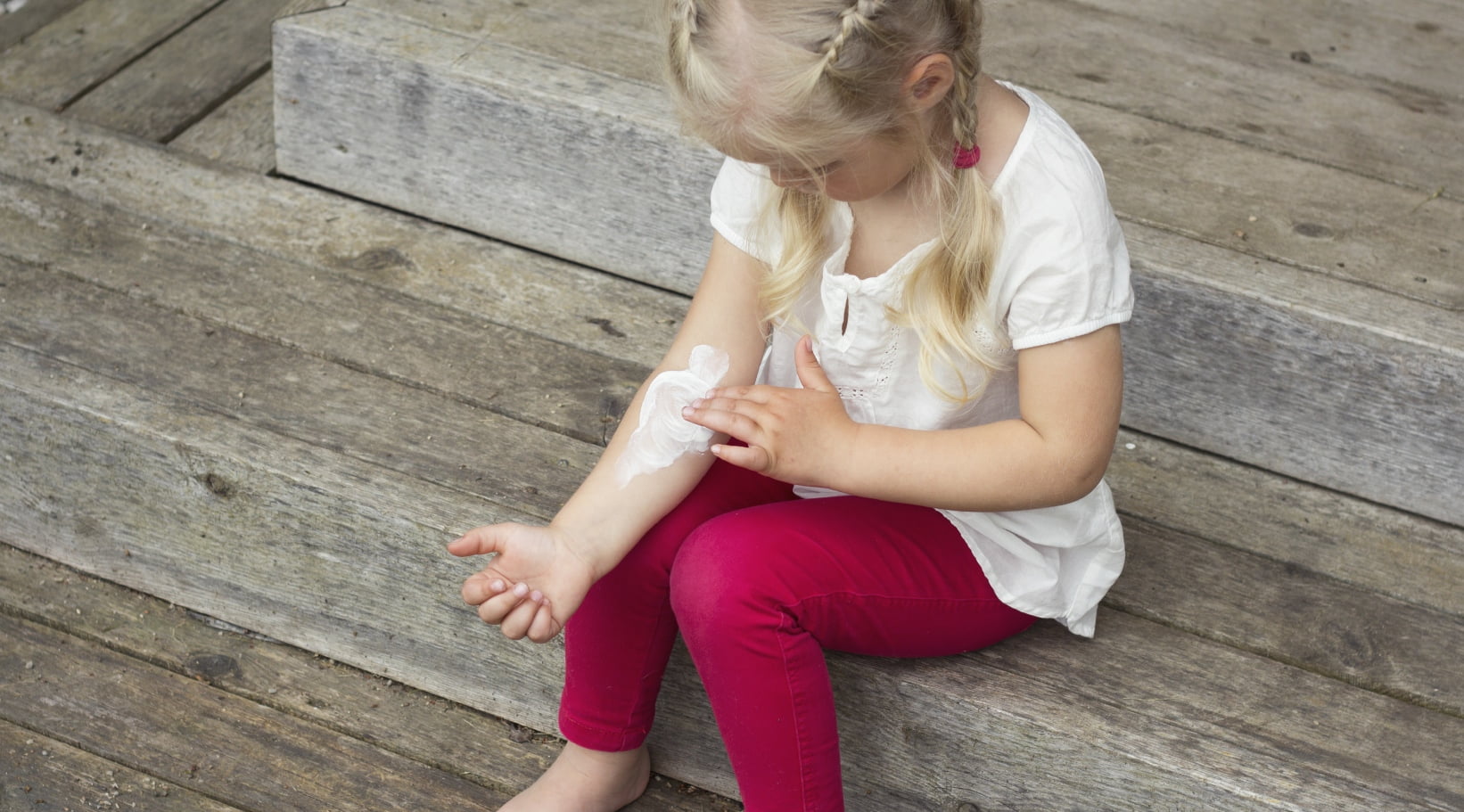In this blog, Sarah Chapman looks at the evidence on tacrolimus for treating children and adults with moderate-to-severe atopic eczema (atopic dermatitis) – is it an effective and safe alternative to other treatments?
Blog last updated: 16 August 2022 to reflect the latest version of the relevant NICE Clinical Knowledge Summary.
Atopic eczema (atopic dermatitis) is a common skin condition that can have a big impact on the quality of life of both children and adults. I’ve been there, managing it for myself and for my children. We’ve been through wet wraps, preparations to put in the bath and to wash with; we’ve read about animals called Itchy and Scratchy who are supposed to make my child feel better about it all; and of course we’ve been through an awful lot of different creams. There are always two pressing questions, once you get onto medicated stuff, usually steroid creams – does it work and is it safe? Possible side effects, such as skin thinning, are quick to be mentioned.
Treating atopic eczema

Topical corticosteroids form the mainstay of treating atopic eczema. A possible alternative is tacrolimus ointment which, along with pimecrolimus, is from a class of drugs called topical calcineurin inhibitors. NICE (2022) says that “tacrolimus may be considered… as a second-line treatmentSomething done with the aim of improving health or relieving suffering. For example, medicines, surgery, psychological and physical therapies, diet and exercise changes. option”. In other words, it may be considered when initial treatment or ‘first-line therapy’ (in this case, topical corticosteroids) doesn’t work, or stops working.
Tacrolimus comes in two strengths, 0.1% and 0.03%. Newer than corticosteroids, it is important to know about its effectivenessThe ability of an intervention (for example a drug, surgery, or exercise) to produce a desired effect, such as reduce symptoms. and safetyRefers to serious adverse effects, such as those that threaten life, require or prolong hospitalization, result in permanent disability, or cause birth defects.. Concerns have been raised about an increased riskA way of expressing the chance of an event taking place, expressed as the number of events divided by the total number of observations or people. It can be stated as ‘the chance of falling were one in four’ (1/4 = 25%). This measure is good no matter the incidence of events i.e. common or infrequent. of cancers such as skin cancer and lymphomas, based on the possible risk of absorption into the bloodstream, but this is controversial, with no strong supporting evidence.
A Cochrane ReviewCochrane Reviews are systematic reviews. In systematic reviews we search for and summarize studies that answer a specific research question (e.g. is paracetamol effective and safe for treating back pain?). The studies are identified, assessed, and summarized by using a systematic and predefined approach. They inform recommendations for healthcare and research. ‘Topical tacrolimus for atopic dermatitis’ was updated in July 2015 with evidence from 20 randomizedRandomization is the process of randomly dividing into groups the people taking part in a trial. One group (the intervention group) will be given the intervention being tested (for example a drug, surgery, or exercise) and compared with a group which does not receive the intervention (the control group). controlled trialsA trial in which a group (the ‘intervention group’) is given a intervention being tested (for example a drug, surgery, or exercise) is compared with a group which does not receive the intervention (the ‘control group’). with almost 6000 children and adults with moderate-to-severe atopic eczema, comparing topical tacrolimus with other active treatments. Previous research has shown that tacrolimus is likely better than placeboAn intervention that appears to be the same as that which is being assessed but does not have the active component. For example, a placebo could be a tablet made of sugar, compared with a tablet containing a medicine. (a similar preparation without any drug). To find out as much as possible about side effects, the reviewers not only looked at dataData is the information collected through research. in the trialsClinical trials are research studies involving people who use healthcare services. They often compare a new or different treatment with the best treatment currently available. This is to test whether the new or different treatment is safe, effective and any better than what is currently used. No matter how promising a new treatment may appear during tests in a laboratory, it must go through clinical trials before its benefits and risks can really be known. but also looked for other types of research, safety letters and industry warnings.
Here’s what the evidence says about tacrolimus for treating children and adults with moderate-to-severe atopic eczema:
- Tacrolimus 0.1% is probably better than low-potency topical corticosteroids on the face and neck and moderate-potency topical corticosteroids on the trunk and extremities
- It’s likely that tacrolimus 0.03% more than doubles the chance of improvement compared with mild topical corticosteroids or pimecrolimus 1%. In most trials, there was probably little to no difference between tacrolimus 0.03% and moderate strength topical corticosteroids, but in two studies topical corticosteroids were probably slightly better
- Side effects:
- Burning and itching may be more common with tacrolimus than with topical corticosteroids but symptoms may be mild and short-lived and there may be little to no difference in skin infection
- Local side effects (side effects which affect the part of the body you’ve applied the cream to) may be more common with tacrolimus than pimecrolimus and last longer: between 30 minutes and 12 hours compared with less than 30 minutes.
- Serious side effects may be rare in all groups and not thought to be related to treatment
- It may be rare to find the drug entering the bloodstream and only in diseases with severe skin barrier problems
- No evidence was found to support the possible increased risk of skin thinning or cancer
How reliable is the evidence?
The evidence was of variableA factor that differs among and between groups of people. Examples include people’s age, sex, depression score or smoking habits. certainty. The drugs, doses and outcomesOutcomes are measures of health (for example quality of life, pain, blood sugar levels) that can be used to assess the effectiveness and safety of a treatment or other intervention (for example a drug, surgery, or exercise). In research, the outcomes considered most important are ‘primary outcomes’ and those considered less important are ‘secondary outcomes’. varied between studies so it was not always possible to combine the results, which is done whenever possible in a systematic review. There’s moderate-certaintyThe certainty (or quality) of evidence is the extent to which we can be confident that what the research tells us about a particular treatment effect is likely to be accurate. Concerns about factors such as bias can reduce the certainty of the evidence. Evidence may be of high certainty; moderate certainty; low certainty or very-low certainty. Cochrane has adopted the GRADE approach (Grading of Recommendations Assessment, Development and Evaluation) for assessing certainty (or quality) of evidence. Find out more here: https://training.cochrane.org/grade-approach evidence that tacrolimus 0.1% is probably better than the milder 0.03% preparation and mild topical corticosteroids. The evidence is less reliable when comparing both strengths of tacrolimus with moderate to potent topical corticosteroids.
The research reported objective measures of improvement and doctor’s assessments of improvement but few reported patient self-assessments; shame!
The bottom line:
The reviewers say: “Tacrolimus ointment seems to be safe and effective for the treatment of moderate to severe atopic dermatitis in both children and adults.”
Links:
Cury Martins J, Martins C, Aoki V, Gois AFT, Ishii HA, da Silva EMK. Topical tacrolimus for atopic dermatitis. Cochrane Database of Systematic ReviewsIn systematic reviews we search for and summarize studies that answer a specific research question (e.g. is paracetamol effective and safe for treating back pain?). The studies are identified, assessed, and summarized by using a systematic and predefined approach. They inform recommendations for healthcare and research. 2015, Issue 7. Art. No.: CD009864. DOI: 10.1002/14651858.CD009864.pub2.
Plain language summary of this review: http://www.cochrane.org/CD009864/SKIN_topical-tacrolimus-for-atopic-dermatiti
National Institute for Health and Care Excellence. Clinical Knowledge Summary: Topical calcineurin inhibitors. London: National Institute for Health and Care Excellence; April 2022. Available from: https://cks.nice.org.uk/topics/pre-conception-advice-management/



I’m glad to see this blog post on the effectiveness and safety of tacrolimus for treating atopic eczema. As someone with atopic eczema, I know how frustrating and debilitating this condition can be. I’ve tried many different treatments over the years, and tacrolimus has been one of the most effective.
I have atopic dermatitis on my face. I was using tacrolimus 0.03%. It’s not healing my dermatitis. I am much worried. I think I should use 0.1% tacrolimus. What say?
Hi my name’s Scott i was using many steroid creams to treat mild exzema on my face , chest and behind ears for a few years and they stopped working and my face became reliant so i stopped using them. Was off the steroid creams for a month and face was itchy, sore, dry and red and i booked to see a skin specialist she gave me tacrolimus I’ve been using it for a week now and face is itchy and a little sore should i carry on or stop as i originally thought i had steroid withdrawal. Thanks
Hi Scott,
This is something you’ll need to ask your clinician or pharmacist about.
Best wishes,
Sarah Chapman [Editor].